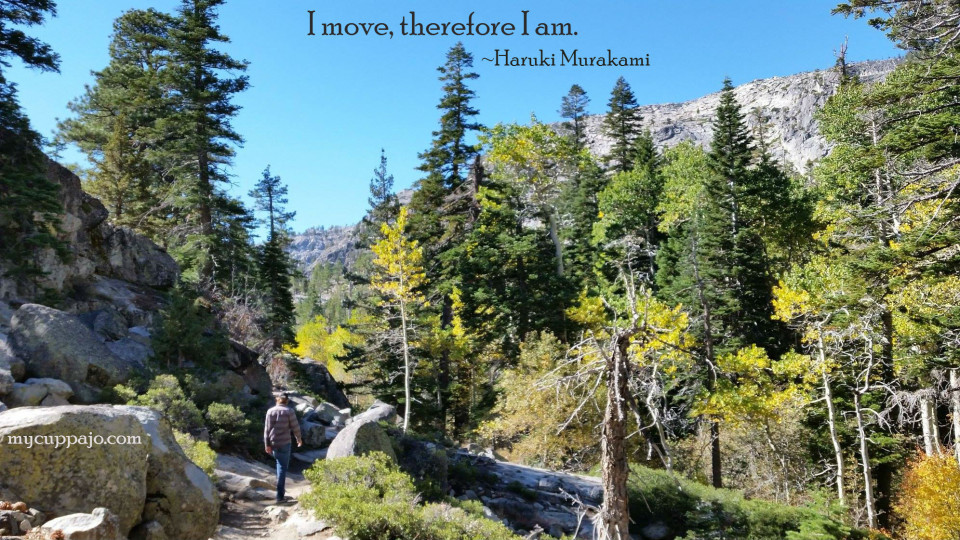My thinking on movement and it’s relation to pain has shifted pretty dramatically over the past couple of years. Before I got hurt, before my surgery and my pain issues, I was a gym rat who loved working out and did a lot of physical training at work. In the gym and on the training grounds, I was a form fanatic, largely in the name of injury prevention but also to be stronger and more efficient, as I think you ought to be when your lifting and throwing a bunch of weight around.
At that time, I also hiked a lot, I ran a lot, I played outside a lot. I didn’t worry about injuries or my form off the training grounds and outside of the gym. In fact, I didn’t think about movement or posture much at all in these environs, I just moved. A lot. I was very active without ever thinking about what my body was doing or how it was doing it. I just did it.
Obsessing about form and posture
That all changed after my injury and surgery, when my pain kept persisting. An injury that didn’t occur while lifting heavy or throwing around a bunch of weight, I just stepped off the fire engine awkwardly on a routine night call.
After that seemingly inconsequential injury – an injury that lead to worsening and persisting pain, to injections and surgery and endless physical therapy, to pain that kept on keeping on – I became a form fanatic in a much different way. I became obsessed with posture and moving correctly. It was no longer something I only thought about while training or lifting heavy, times when it’s pretty appropriate to focus on form and posture, rather, it was something I thought about, obsessed about, and worried about ALL THE TIME.
Every moment, every movement, I thought about my posture and form. I thought I had to, in part as a result of well-meaning physical therapists, teachers, and trainers stressing how important my joint position, my alignment, my core engagement, my glutes firing, my muscle balance and symmetry, were to getting out of pain. All things I hadn’t thought about much, things that hadn’t caused me pain before I got hurt but that were now blamed as the culprit in my persistent pain issues.
Things that I needed to fix in order to get out of pain.
 I became terrified of moving wrong, of sitting wrong, of breathing wrong, of doing everything wrong; wrong being in ways that were going to exacerbate or prolong my pain. And even though I focused on it so, so much, I was obviously still doing it wrong because I was still in pain.
I became terrified of moving wrong, of sitting wrong, of breathing wrong, of doing everything wrong; wrong being in ways that were going to exacerbate or prolong my pain. And even though I focused on it so, so much, I was obviously still doing it wrong because I was still in pain.
Self-blame, stress, anxiety, increasing pain
So I focused on it all the more: all day long I thought about how I was moving, sitting, breathing, walking, stepping, sleeping. It was exhausting, it was extremely stressful, it was incredibly unhelpful. And I still I couldn’t seem to get it right. Despite earning my M.S. in kinesiology, despite having been a fitness trainer, a firefighter, a heavy lifter, a runner, an athlete, an active outdoorswoman, despite being a mover all my life. all of sudden my movement was causing me pain, all of a sudden I sucked at it.
I couldn’t meet the external ‘ideal’ of movement and posture I thought I had to achieve to get out of pain.
So I focused on it even more. It became a vicious cycle, pain increases…I must be moving wrong or sitting wrong or breathing wrong…focus even more on moving right and sitting right and breathing right…pain increases…I must be doing it wronger!…focus on it more….
It also didn’t help that, according to the magazines, to social media, to many of the the trainers, coaches, orthos, and physical therapists in my circles, to some of my instructors in school, improper movement and poor posture is what’s causing us pain, what’s killing us. This heightened my worry, my anxiety…my fear that I would never get it right, that I would never get out of pain.
Posture and movement
I admit, I used to think along similar lines. I used to think that moving poorly and poor postures were what caused pain and injury. I don’t think that anymore. There’s plenty of people with poor posture or poor movement who have no pain. And there’s plenty of people who have excellent posture, who move really well, who have unbearable pain.
I do think posture and movement are important, but in a much different way, now. In my current view, it’s not poor posture or poor movement that cause pain, rather, it’s not shifting postures, not moving, whatever it may look like, that contributes to pain. Any sustained posture, no matter how correct or perfect it is, is going to lead to discomfort. As I’ve said plenty o’times before, movement is life.
So I don’t think there is such a thing as universally correct movement or perfect posture: there’s no one-size-fits all ‘ideal’ of movement or posture that we should all be striving for. It’s possible that striving for such an externally derived, universally applied ideal can actually worsen our pain, especially when we can’t quite get there, when we fail, when in our pursuit of such a one-way-fits-all ideal, one that has nothing to do with us as an individual, our movements become forced, prescribed, overly controlled: all effort and no ease, all to no avail for many of us.
I think being stagnant, not moving frequently through different postures, not breathing naturally, not being able to let go of the tension that arises from the stress fear and worry of being in pain, are major contributors to our prolonged pain. And what’s natural, what’s ‘normal’, what’s desired, is going to be different for each of us: there is no universal ideal. We’re all different, with different anatomies, different strengths, different needs, different goals.
The key is movement (preferably determined by the individuals likes, needs, inclinations, goals) and moving through a variety of postures throughout the day, not performing specific movements or maintaining correct postures throughout the day.
A shift in thinking in the making
How did this vicious cycle start for me? Why, all of a sudden, was I so preoccupied with movement and posture being right, all the time? With it being so necessarily specific, prescribed, uniform…ideal? I’m not talking lifting heavy or physical training, here. I’m talking about being preoccupied with form and posture in everyday movements: walking, sitting, bending over, sleeping. I never thought about such things before I got hurt, before my pain issues.
Why such an emphasis now? Why was I so hyper-vigilant? Was it warranted? Was it helpful?
I think much of my preoccupation with form and posture stemmed in part from the current health and fitness culture, where movement is always being corrected, coached, and suppressed, especially when one reports pain, rather than movement being explored, enjoyed, and uniquely expressed.
Nowadays, the prevailing thought seems to be that movement can be wrong and should be corrected, that posture can be wrong and needs to be vigilantly monitored and maintained. I was even taught this in some of my coursework in school and it was definitely a prevailing thought for many of the students, all people who work in movement-based professions, all people who work regularly with people who experience pain.

But it wasn’t always like this for us, even for those who believe it now. When we were little kids, we moved how we wanted to move all the time. We ran, skipped, climbed, crawled, danced, wiggled, fidgeted, hopped, twirled, jumped, flipped, and just goofed off.
There was no right or wrong movement, no right or wrong posture.
We weren’t self-conscious, we weren’t worried about what other people thought of how we were moving or if we were moving in some ‘right’ or socially acceptable way. We didn’t think about it. We just moved.
Back then, it’s as if we knew there wasn’t a right way to move, as if we were discovering our own way of moving, our own way of interacting with the world. We were figuring it out on the fly.
We explored movement, we were creative, we pushed boundaries, we expressed ourselves through action and motion. We didn’t hold ourselves back. We sought our physical limitations, and then sought to push past them. We didn’t follow movement rules (well, we did follow some rules when I was a kid. Rules like no stepping on cracks, having to hop on one foot until the next street light, only being able to run backwards, etc. Fun movement rules, which were temporary in nature, especially if we broke a particular rule and then changed it to some other rule that we were better at).
We didn’t need correction.
At least not until we were told to sit still, to stop fidgeting, to mind our manners. We were in public, so we had to knock it off. We were in school, so we had to sit at attention. (Tangent: where in the world did we get the idea that the only way to pay attention is for us to sit or stand at attention? That’s quite possibly the worst way to get kids – and adults – to pay attention. All you can think about is how you want to move, not whatever is being instructed. Or we go to our happy place in order to not focus on not being able to move, which also means we’re not paying attention.)
Somewhere along the way, we started to become self-conscious. We started conforming to what was expected of us. We stopped moving so damn much. We stopped moving how we wanted to, we stopped exploring movement, stopped getting creative with movement, stopped testing and nudging our physical limitations – I mean, what if somebody saw us?
We started following movement rules.
We lost much of the variety of our movement: the spontaneity, the creativity, the joy, the ease.
And now, all these years later, we’re still sitting still, we’re still not fidgeting, we’re still minding our manners. We’re still trying to match some expected, external ideal of perfect posture and restrained movement and propriety.
We’re stifled
And when we’re in pain, we’re stifled even more, our movement is further prescribed, further restricted, more narrowly and externally defined. We become more self-conscious. We become more worried and anxious and fearful. There are parameters placed on movement that we’re not supposed to go outside of, movement ideals we’re supposed to attain, lots of movement rules to follow.
And because we’re supposed to move in certain, specified ways, movement becomes a thing we have to do, an onus, a chore, a burden, rather than just a thing we do.
But what if those prescribed movements, those narrowly, externally derived movements aren’t the way our body wants to move? The way our body can move? And what if those prescribed movements become the only way we think about movement?
That’s the trap I got stuck in, that I think many folks in rehab get stuck in. Movement becomes a thing we have to do, it’s no longer something we just do naturally. Movement becomes a conscious act, something we must think about ALL THE TIME to get right. We have to focus on the specifics of it: how we’re supposed to do it and, more importantly, how we’re not supposed to do it.
And many of us feel like we’re doing it wrong, because we’re still in pain.
Moving wrong vs not moving naturally
When did movement become a thing we could get wrong? We’ve been moving all our lives and we’ve done it pretty damn well. We used to be able to get from A to B without thinking. We could run, skip, throw, jump, bend, squat, lunge, sit, crawl, climb, walk. Play.
We didn’t need rules to do these things, to move.
I feel like many of us have forgotten how to tap into our natural inclinations to just move. Now we often think of movement in terms of exercise, as a prescription to do something, especially if we’re rehabilitating or in pain. And when we’re rehabilitating or have pain, it seems like were told a lot of movement is off limits (which can make movement a bit scary), and the movements we are allowed to do, that we’re supposed to do, are very specific, are externally determined, and must be executed within a narrow set of parameters, for a certain number of sets and reps or a specified number of seconds or minutes.
“There can be no transforming of darkness into light and of apathy into movement without emotion.” – Carl Jung
It feels artificial, unnatural, external, and it doesn’t seem to cross over much into our every day lives, it’s not meaningful. If a person’s goal is to hike the Appalachian Trail or go golfing with their buddies or go back to work or get on the ground to play with their grandkids without pain, how are 3 sets of 10 reps of clam shells and glute bridges going to get them there? It’s hard for folks to make the connection. And it’s easy to get good at clamshells and glute bridges and not get good at hiking or golf or getting back to work or getting on the ground to play with the grandkids without pain.
Externally derived movement prescriptions put us in a very small box that’s hard to climb out of, and even harder to get comfortable in.
And being in that box, it becomes harder and harder to know what natural movement feels like, it becomes harder to not fear movement if there is a chance we could do it wrong.
becomes harder and harder to know what natural movement feels like, it becomes harder to not fear movement if there is a chance we could do it wrong.
When we try so hard to follow the prescribed movement rules, where does all our natural, pent up, stifled movement go? What else is being affected by our restraining our movement so much throughout the day? What happens when we don’t measure up to the movement or postural ‘ideal’?
For me, it lead to self-blame, to renewed, misdirected, intense focus on maintaining correct postures and performing movements correctly, rather than focusing on moving through postures, exploring movement, finding my physical limits and nudging them a bit to see if I could go a bit further, easing into movements that I was afraid of or worried about…in other words, moving naturally, in ways that felt good, finding my ways of movement, ways of movement that were meaningful, useful, and enjoyable to me.
I got really good at doing my prescribed movements. I didn’t get so good at moving without pain (or fear) in my every day life.
So I was a success, in clinically defined terms. I had good range of motion. I had good strength. I could physically do everything asked of me in the clinic, even when my pain levels were up. I was very functional. But I couldn’t do everything I asked of myself in life, I couldn’t do everything I wanted to do in life, or at least I felt like I couldn’t, which amounts to the same thing.
This was not success.
When we’re solely prescribed movement in the form of sets and reps and an external ideal of form or posture, rather than encouraged to explore our innate inclinations to move our bodies in ways that come naturally, what does that do to our activity levels, our pain levels, our physiological functioning, our cognitive abilities, our creativity, our emotions, our thoughts, our being?
What does that do to our bodies and minds?
Ponder that for a bit and stay tuned for part 2: Bam! Thought shift! Just Move :)
Photo above is of my husband, walking along a trail in Lake Tahoe, California. He’s moving just fine.
Right and wrong images courtesy of Stuart Miles at FreeDigitalImages.net; Man in box image courtesy of Master isolated images at FreeDigitalImages.net
Thanks for reading, folks, I appreciate you sticking it out! This is a long ass post, which has already been cut in half – scary, I know! I’m not really so good at conciseness, eh?
As always, I appreciate your thoughts and feedback – please feel free to leave a comment or send me and email. Or hit me up on Facebook or Instagram, if you’re into that sort of thing.
If you liked what you read, share with your friends! Or sign up for the monthly-ish newsletter that has additional stuff I find interesting, and hope that you’ll find interesting, too.


Pingback: Cognitive Functional Therapy with Peter O’Sullivan - Physio Network